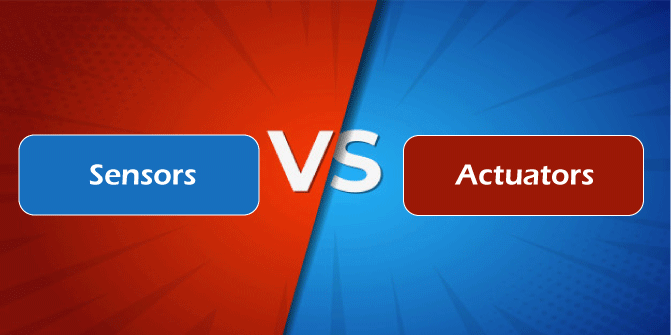Difference between Sensors and ActuatorsSensors and actuators are critical components of embedded systems. These are utilized in various real-world applications, including flight control systems in aircraft, process control systems in nuclear reactors, and power plants that require automated control. Sensors and actuators differ primarily in their purpose; the sensor is utilized to track environmental changes using measurands, whereas the actuator is utilized when monitoring is combined with control, such as controlling physical changes. In this article, you will learn about the difference between Sensors and Actuators. But before discussing the differences, you must know about Sensors and Actuators with their types and features. What are Sensors?A sensor is a device that detects changes and events in a physical environment. It may convert physical parameters like humidity, pressure, temperature, heat, motion, etc., into electrical signals. This signal can be converted into a human-readable display and sent across a network for additional processing. Active sensors and passive sensors are the two primary types of sensors. Active sensors necessitate a power supply, whereas passive sensors don't require a power supply. There are various types of sensors available, including temperature, ultrasonic, pressure, and location sensors, among others. They are utilized for detecting and measuring the relevant quantities. A sensor works by sensing a quantity by utilizing a particular detecting device. Each sensor operates on a distinct principle, such as an electromagnetic sensor, a resistive sensor, a capacitor sensor, etc. In general, they sense the matching attribute in the environment and convert it into a proportional magnitude electrical signal. Some important sensors are as follows: 1. Biosensors These biosensors utilize electrochemical technology. These sensors are used in medical, food, and water testing devices. These biosensors also aid in analyzing proteins, cells, nucleic acid, etc. 2. Accelerometers These sensors utilize the Micro Electro Mechanical Sensor Technology. These sensors utilize in patient monitoring, vehicle systems, etc. 3. Image Sensors These sensors utilize the Complementary Metal Oxide Sensor mechanism. They detect and transfer data that is utilized to make an image. These image sensors are very useful in consumer surveillance and electronic systems. 4. Chemical Sensors These sensors use ultrasonic, microwave, and radar technology, and they are used in security systems, video games, and other applications. Features of SensorsThere are various features of Sensors. Some main features of Sensors are as follows:
What are Actuators?A device that changes electrical signals into mechanical work is known as an actuator. It is used to cause movement or a change in the surroundings. For instance, a fan is utilized to lower the temperature, and a servo motor is utilized to change position, among other things. Actuators are connected to a system's output. It receives an electrical signal as input and produces mechanical movement as output. It receives input or instruction from a system or a signal conditioning device and outputs it to the environment. The actuator is dependent on the sensor data. The sensor sends data to a signal condition unit, which analyzes the data or information and transmits commands to the actuator depending on that data. A "temperature control system" is an instance of an actuator system in which a temperature sensor manages the temperature. If the temperature surpasses a specific limit, the device instructs the fan to increase its speed and decrease the temperature. Types of ActuatorsThere are various types of actuators. Some of these are as follows: 1. Manual Actuator This type of actuator is manually operated via gears, levers, and wheels, among other things. They do not need a power source because they are powered by human action. 2. Spring Actuator It has a loaded spring that is triggered and released to generate mechanical work. It may be triggered in several ways. 3. Hydraulic Actuator Hydraulic actuators generate pressure by compressing fluid in a cylinder, allowing mechanical movement. 4. Electric Actuators These actuators require power to function. It utilizes an electric motor to produce movement. They are quick and effective. Features of ActuatorsThere are various features of Actuators. Some main features of Actuators are as follows:
Key Differences between Sensors and Actuators
There are various key differences between Sensors and Actuators. Some main differences between Sensors and Actuators are as follows:
Head-to-head comparison between Sensors and ActuatorsHere, you will learn the head-to-head comparisons between Sensors and Actuators. The main differences between Sensors and Actuators are as follows:
ConclusionThe primary distinction between a sensor and an actuator is that a sensor is utilized to detect environmental changes. In contrast, an actuator is utilized to control environmental or physical changes. Sensors and actuators are both required for the system to perform properly.
Next TopicDifference between
|
 For Videos Join Our Youtube Channel: Join Now
For Videos Join Our Youtube Channel: Join Now
Feedback
- Send your Feedback to [email protected]
Help Others, Please Share










